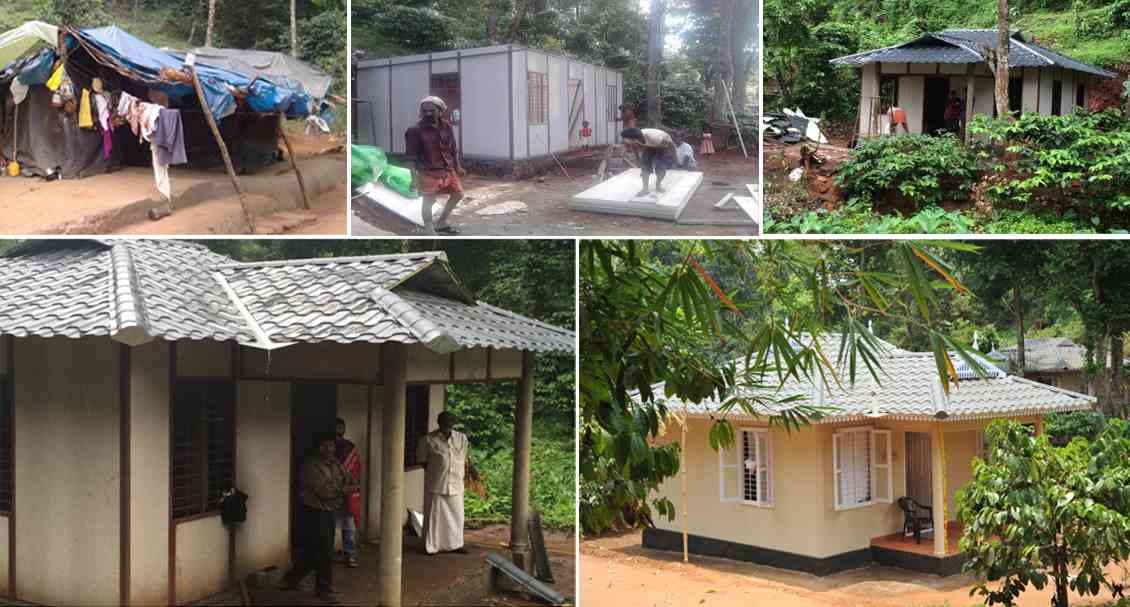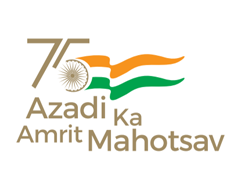" SADHGRAHA " - Sheltering humanity
INTRODUCTION:
The tribal population is interspersed across the country and has placed differently with respect to the political administrative structure existing in India where there are numerical minorities. There are certain constitutional rights conferred to Scheduled Tribes to safeguard their interest, and several privileges and reservations were also accorded to them in educational institutions and government employment. However, there are two major prerogative declarations made for them in the constitution in the form of the Fifth and Sixth Schedules.
The Sixth Schedule of the Indian Constitution articulates autonomous districts and regions as some of the areas in the states of Assam, Mizoram, Meghalaya and Tripura are excluded under Article 244(2) of Government of India Act, 1935. The Fifth Schedule Provisions to the Administration and Control of Scheduled Areas and Scheduled Tribes under Article 244(1), which aims at providing protections to the tribal population through separate laws for the Scheduled areas and the institution of Tribal Advisory Council, including a special role for the Governor who may make rules and regulation for peace and good government of any area in a State which is for the time being a Scheduled Area.
Despite these special provisions, tribes are among the most substandard and marginalized sections of Indian society even today. Although numerically about 8.6 percent of the total population was below the poverty line as per 1993 -94 poverty statistics table. At all-India level, the poverty ratio for the rural areas was 37.3 percent in the same year. Highest percentage of people below poverty line was found to be Scheduled Tribes as compared to other social groups and urban regions of the country.
LIVING STATUS OF TRIBES:
Tribal people are the guardian of forest and forest resources as they are the denizens of the place from a very long period. This is the reason why they are been called as “Adivasis”, which means the old natives of the land or original inhabitants. These indigenous people completely pin their faith on forest and greenwood. They find their source of income and sustenance from forest without blighting the soul and spirit of the woodlands. Tribal rituals show reverence and respect for forest and extoll the same as divine being. They worship several animals and trees as the supreme power. In India, majority of the tribes are living in various ecological and geo-climatic conditions and inaccessible areas. As per the demographic status of the tribal population, nine states cover around 8.6% of the nation's total population and over 104 million tribes are ensconced in the country. Unlike the educated urban community , tribal groups are cognizant of the circumstances that forest is their means of support and life so it is their responsibility to protect their place of residence. Few decades back they were unenlightened about the provision of electricity, and the only light known to them was the beams of sun and fire, even today, many of the tribal hamlets doesn't have electricity service, water facility, and proper shelter. India have distinct number of tribal communities, each community has their own culture, tradition, language, custom, habiliments , belief system, festivals, etc. So is the housing style of each community residing around the country as they are unalike in manner and appearance; except one thing, all are non – electrified, without proper water supply, sanitation and adequate sewage disposal. Regrettably, they do their utmost to live in an incapacitated house. They are grappling with the cramped room for both the purpose of cooking and sleeping . The deteriorating condition of the house intensifies as there is no one to purvey. We cannot even presume a house which may not have a well- fortified doors and windows, or an unconsolidated living.
TRIBAL WOMEN SECURTY:
The condition of the tribal women are even worse and frightful. A study conducted by the Kerala State Women’s Commission into the lives of tribal women have some shocking revelations that would put the state to shame. Among the tribal women, more than half of them have faced various kinds of sexual harassment. Around 50 per cent women unveiled their dreadful experience of sexual exploitation and the rest divulged their inability to defend themselves and question the tormentors. Majority does not have a proper shelter to live in, and 53.5 per cent of women do not have guardians to afford protection to them against exploitation. Shockingly, 76.08 per cent are deprived of daily meal and more than 90 per cent do not have a daily job. In the case of Adivasi women, majority work for daily wages of less than `50 rupees and most of them are immersed in debts. Around 22 per cent women revealed that they are being forced into prostitution. The living conditions of the tribal women are so pathetic and harrowing. There is no facilities of water closet or toilets for 40.67 per cent. The study also found that the health condition of almost 90 percent of tribal women was unsatisfactory and stagnant. More than half of the tribal women give birth to a child between 20-25 years. Most of them did not get enough care during their pregnancy period. Majority of them have some psychological instability, 71.31 per cent of tribal mothers suffers from depression and around 48 per cent have anxiety disorders. Around 63 per cent have sleep disorders as well. T. Devi, a member of Women’s Commission , who has been working among tribal women since 1984, and has enunciated that the condition of Adivasi women are debilitated and degenerated.
ABOUT SADHGRAHA
One of its prime projects of HRDS INDIA is “Sadhgraha”, a Tribal housing project all across India, particularly in seven major states, wherein they facilitate free boarding and lodging to tribal children for higher education and ensures the promotion of participatory character of the highly backward and deprived children by organizing them into better social collectives. The ongoing execution of the same exhibits the project’s headway in leading it to wider horizons.
Majority of the Indian Tribes are deluged in poverty; Unemployment, Malnutrition, Infant mortality, Low literacy rate, etc. are some common factors among them. Here HRDS INDIA is introducing a new way of housing technology for the tribes in India. “SADHGRAHA” ,the Tribal Housing Project, which aims to construct Ten Million houses for the homeless tribes across India at a cost of Rs. 500051,70,00,000. Cement Fibre Panels which is a new strategy used for constructing homes to maintain environmental sustainability. Fibre Cement Panels are mainly cement bonded particle boards and cement fibre. It is considered one of the major contributions to the society to reduce global warming, which may take only 12 days to complete a fully furnished house at a cost of 4 lakhs 92 thousand for 370 Sqft with Traditional Indian Architectural design. HRDS INDIA believes that Shelter is the foundation of development, and through “SADHGRAHA” we can bring the Tribal groups into the mainstream of the society, and this project will make a noticeable change in the lives of Tribes in India.
Reformation of Tribal Life
BUILDING HOUSES FOR THE HOMELESS AND SHELTERING NOT ONLY HUMANS BUT NESTING THE DREAMS AND HOPES….OF THE MILLIONS OF PEOPLE AROUND US.

Tribal house building phases

Sadhgraha Plan and Estimate
SADHGRAHA tribal house key handover ceremony for Actor Mony
HRDS INDIA is introduced for the upliftment of the tribal people of Palakkad, Wayanad and Idukki districts as well as with an altruistic sentiments of saving these inhabitants from the deplorable conditions in which they live. Primarily the project envisages building houses for the poor deserving dwellers of the sited districts. This can be made feasible only to those who own at least 3 cents of plots in the area of the project. It has been assessed that by providing new houses they can escape from the hazardous climatic conditions and kindles a light of hope in their minds. For maintaining a reasonable standard of living, they would be given training in skilled labour, especially to the women of the tribe. Thus they can give unawareness of the importance of stable employment and the enjoyment of a meaningful life. The houses to be build with “ Fibre Cement Panels” a totally new building material were used in constructions. These Panels, manufactured with eco- friendly components, can stand the test of time and are ideally suitable for the extreme climatic conditions of the said districts. For strength and viability, these ‘ Fibre Cement Panelss” have been awarded wealth certificates of approval by “CII green products and Service Council”
Press Conference
Tribal population is very high in various States of our Country. Most of the Tribes are situating in very poor living conditions. More than half of the Tribal population resides in six states: Madhya Pradesh, Chhattisgarh, Maharashtra, Orissa, Jharkhand and Gujarat. The Northeast of India has a particularly heavy Tribal element. These ancient aboriginal peoples tend to live in isolated communities in hills and forestlands, far from urban centers. There are 4614 landless Tribal families in the State of Kerala. In this circumstances of Kerala more than 55 percent live in dilapidated houses. In all, 39,850 houses do not have kitchen and 49 percent does not have toilets. Half of the population deprived of pure drinking water and 1252 Tribal hamlets are not electrified. More than 1300 Tribal settlements face threat from wild animals. Many of the families do not have any access to medical care. Among them 4,036 are differently disabled and 2386 are mentally-challenged. The community has 40,323 chronic patients. The literacy rate among the scheduled Tribes is 72.77.
" SADHGRAHA " Tribal house key handover ceremony
Most of them used to drop out from schools at the primary level itself. Poverty and lack of access to educational institutions are the major reasons. Dress pattern of the Tribes is Kerang Saree reaching half way of the knee, great rings on their neck, rings on their fingers, brass bell on their toes, heavy brass bangles on hand and various necklaces in their neck. Tribes used to build a shed for domestic animals outside their residence with homogenous pattern. The walls are made of mud or stone with a number of pillars supporting the roof, which is thatched with forest grass or paddy straws. Typically most of the houses don’t have windows. In some places the houses built with loosely layered stone walls for the boundary and plastic sheets as roof. The soil of the projects sites are mostly red, mixed red, alluvial, red and black. Texture in most of the locations is sandy and clay loam. Ph level is most suitable for cultivation and its fertility status is very high.










































